As April has been the first full month of lockdown with no flying at all this Patch News will be concentrating on how we’ve all been keeping busy. However, the patch hasn’t been totally forgotten and some members have been along and checked the fence as part of their daily exercise. The battery has been changed regularly and everything is in order which is fortunate as Woody reports that the bullocks are due to return shortly. Dougal Entendre pointed out that the photos of the patch area have been updated on Google Maps and now show some of us at the field. It’s even possible to see the spot and now I know why I didn’t win the spot landing comp, the spot isn’t in the middle! Obviously all my spot landing attempts were dead centre of the patch…
Dougal Entendre pointed out that the photos of the patch area have been updated on Google Maps and now show some of us at the field. It’s even possible to see the spot and now I know why I didn’t win the spot landing comp, the spot isn’t in the middle! Obviously all my spot landing attempts were dead centre of the patch… 
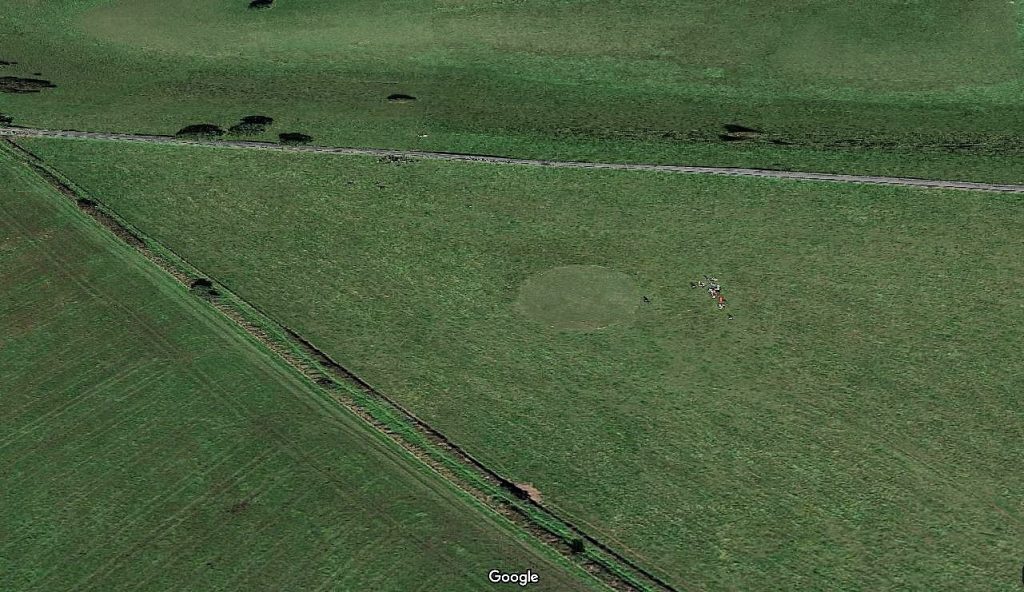
My request for photos and information about your projects has been answered with a deluge and I now have enough material for at least two editions. Thank you all for your contributions, Patch News wouldn’t be possible without them especially during lockdown. If your model doesn’t feature in this edition it will be in the next one.
I’ll begin with one of several of Norwegian Nick’s projects, definitely a major project, a Blackburn Buccaneer.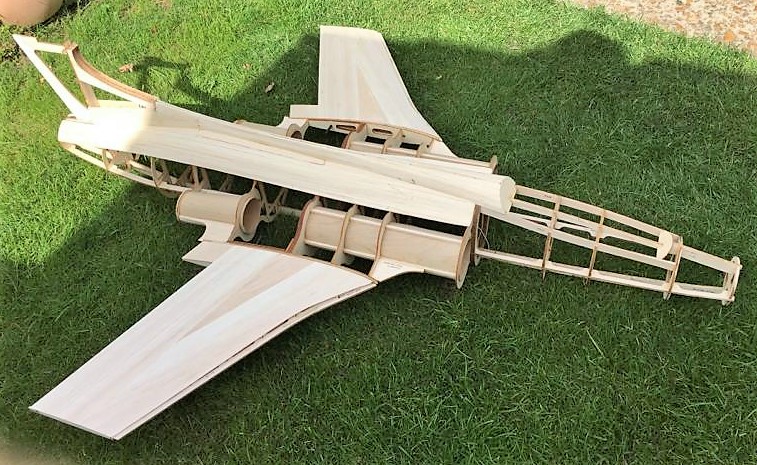 Nick mentioned that back in his naval days he’d worked servicing Buccaneers for three years so I asked him for some more information: I got drafted from H.M.S. Bulwark, a commando carrier with just Wessex Helios in 1975 to RAF Honington in Suffolk which had a detachment for 809 squadron Buccaneers. We had 3 of the squadron Buccs already to go in case they lost any when they were deployed on Ark Royal which was deployed over the pond to the USA. We also looked after and maintained 4 RAF Buccaneers of 208 conversion unit which trained RAF pilots and observers for front line squadrons. Prince Charles in his youth was going to visit the Ark Royal in the North Sea and we had to provide him with one of our Buccs. We were sent up to the Firth of Clyde to embark on Ark Royal, he then flew on board and stayed for 4 hours then flew off. We as the maintainers were then flown off to Lossiemouth and then back to Honington by a Sea Devon aircraft. Now I can see why Nick wanted to build one.
Nick mentioned that back in his naval days he’d worked servicing Buccaneers for three years so I asked him for some more information: I got drafted from H.M.S. Bulwark, a commando carrier with just Wessex Helios in 1975 to RAF Honington in Suffolk which had a detachment for 809 squadron Buccaneers. We had 3 of the squadron Buccs already to go in case they lost any when they were deployed on Ark Royal which was deployed over the pond to the USA. We also looked after and maintained 4 RAF Buccaneers of 208 conversion unit which trained RAF pilots and observers for front line squadrons. Prince Charles in his youth was going to visit the Ark Royal in the North Sea and we had to provide him with one of our Buccs. We were sent up to the Firth of Clyde to embark on Ark Royal, he then flew on board and stayed for 4 hours then flew off. We as the maintainers were then flown off to Lossiemouth and then back to Honington by a Sea Devon aircraft. Now I can see why Nick wanted to build one.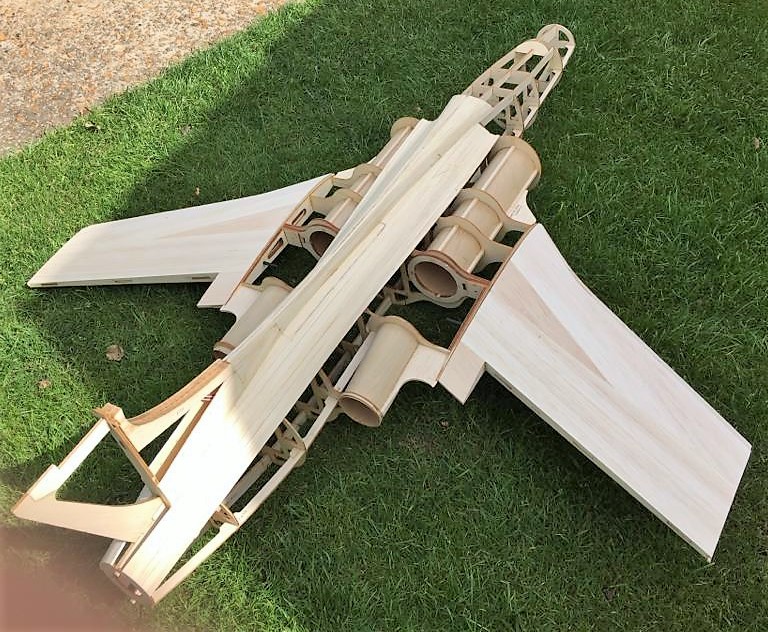 Nick chose a Mark Douglas designed Buccaneer S2 kitted by Belair Kits. The fuselage is 1925mm in length and it has a wingspan of 1350mm, AUW should be around 10 lb 4 oz. Nick has bought two Lander 76 mm fans at 1600W each and two 85A esc’s that will be fed by two 6 cell 6000mAh lipos. The servos are a mix of Hitec 225s and HS 125s.
Nick chose a Mark Douglas designed Buccaneer S2 kitted by Belair Kits. The fuselage is 1925mm in length and it has a wingspan of 1350mm, AUW should be around 10 lb 4 oz. Nick has bought two Lander 76 mm fans at 1600W each and two 85A esc’s that will be fed by two 6 cell 6000mAh lipos. The servos are a mix of Hitec 225s and HS 125s.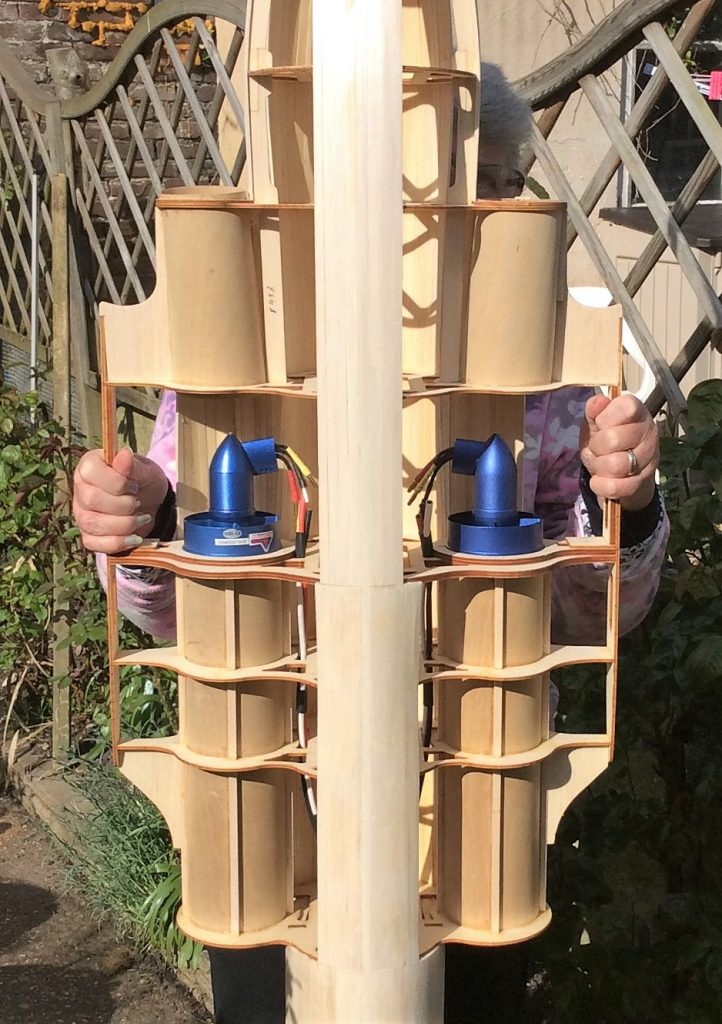
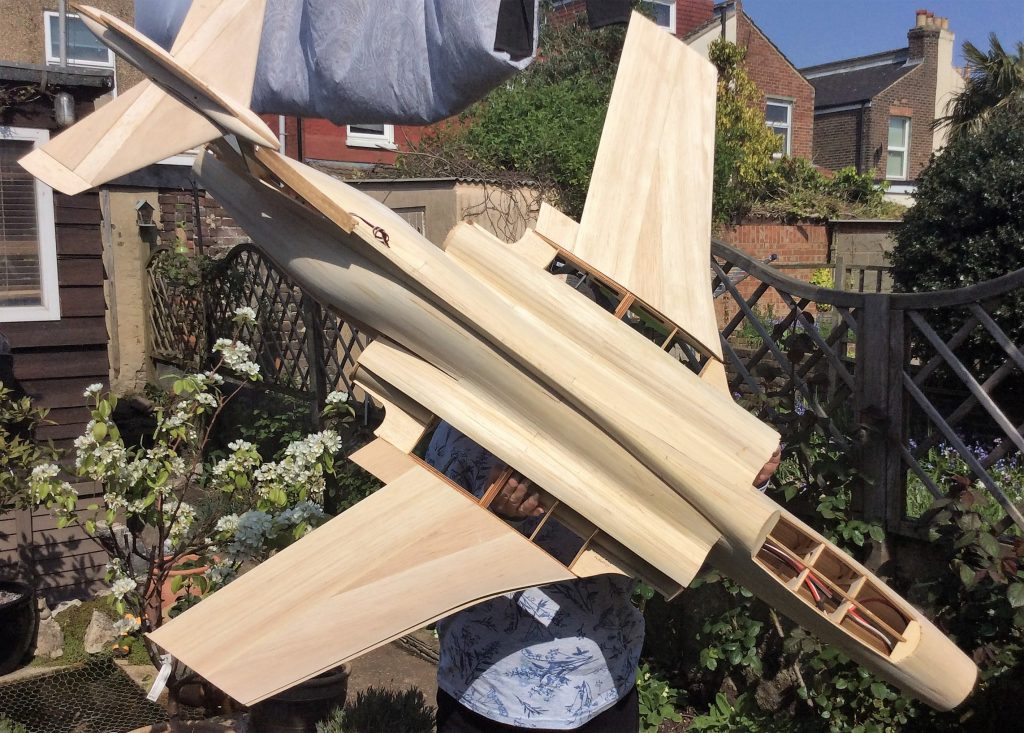 The fuselage construction consists of framed bulkheads spaced by longerons and then the whole fuselage has to be planked due to the shape. Nick admits it’s a pain but says he’s winning and once finished it will be sanded to shape and then glassed. The wings were built as normal with spars and ribs and then sheet balsa covered. Wow Nick, just wow, that’s a heck of a project! I’m really looking forward to seeing the completed model.
The fuselage construction consists of framed bulkheads spaced by longerons and then the whole fuselage has to be planked due to the shape. Nick admits it’s a pain but says he’s winning and once finished it will be sanded to shape and then glassed. The wings were built as normal with spars and ribs and then sheet balsa covered. Wow Nick, just wow, that’s a heck of a project! I’m really looking forward to seeing the completed model.
You’ll be amazed to hear that Dougal Entendre has bought another transmitter as he was down to his last twenty or so! He sent me his excuses reasons. My reason for buying the Jumper T16 was in part because it uses the OpenTx software. I thought I really ought to get to grips with that, as Tx software used to be a major interest of mine back in the 20th century. But also the T16 is a multi-protocol Tx, so in theory I could use it for all my existing Walkera Devo receivers, plus any bind-n-fly indoor models I might choose to buy. These tend to use Spektrum or Frsky-compatible receivers, or various other makes, and all I would have to do is select the right protocol for each model.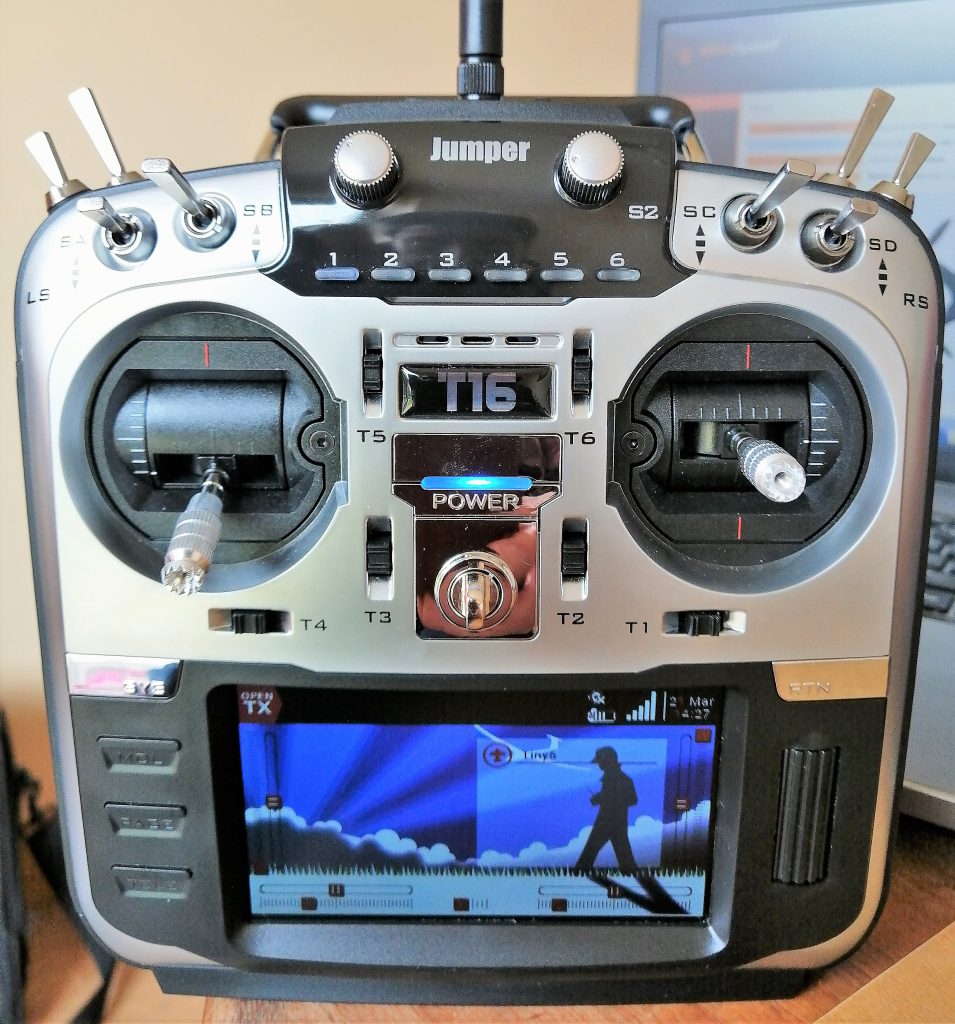 Actually getting hold of a T16 proved to be tricky as everywhere seemed to be out of stock, or charging about £200 for it, or both. I eventually found a supplier on Amazon.com (the USA site), who said they could get it to the UK for £135 (including customs duty). I ordered it in late January, and it reached me as promised in the middle of March.
Actually getting hold of a T16 proved to be tricky as everywhere seemed to be out of stock, or charging about £200 for it, or both. I eventually found a supplier on Amazon.com (the USA site), who said they could get it to the UK for £135 (including customs duty). I ordered it in late January, and it reached me as promised in the middle of March.
It’s a good looking Tx which seems to be styled after a current Futaba model, and has a colour screen. It’s not a touch-screen – it uses a roller and pushbuttons just like the old Spektrum DX8 I had about 7 years ago. The sticks have Hall effect sensors instead of pots, so they have a very smooth feel to them. You have to provide either a 2s LiPo battery, or a pair of 18650 Li-Ion cells. A piece of equipment I’ve been designing at work uses the latter, so you’ll never guess what I ended up with!
It all sprang into life when I powered it up, but it soon became apparent that the roller switch was working very intermittently, and some of the pushbuttons didn’t seem to work at all. On subsequent power-ups the screen displayed a message that it had a stuck key. My heart sank as I contemplated returning it, but a Google search revealed quite a few other people had had this problem, and it could be solved by re-seating a couple of ribbon cables inside the Tx. So, following the advice of a YouTube video, I undid the screws to open the Tx, then set about undoing the connector clips at each end of the first ribbon cable. This cable was only about 2.5cm long and 0.5cm wide. When I undid the second connector clip there was a “ping” and the ribbon cable disappeared. It had obviously been held in compression, and had now pinged off to God-knows-where. I spent about 20 minutes searching the floor for it to no avail. I tried shaking the Tx upside-down, but nothing fell out. Eventually I found the ribbon wedged behind one of the PCBs in the Tx, to my great relief.
I eventually completed the reseating for both cables (carefully!) and screwed the Tx back together. The message about a stuck key didn’t show on the splash screen when I powered up, and what’s more, all the pushbuttons and the roller now worked properly! A good result, but one has to question the manufacturer’s quality control.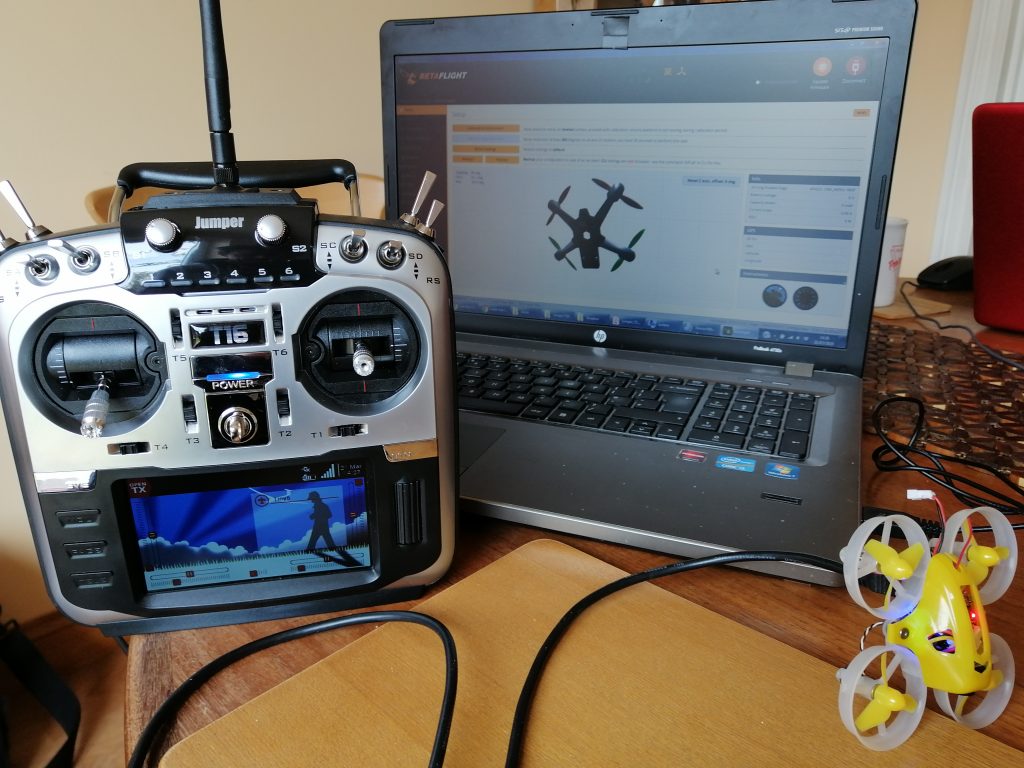 The next thing to do was check the version number of the firmware. Sure enough there was an update on the Internet, and apparently it was an important fix for a couple of bugs. So I had to download OpenTx Companion on my PC, and connect the Tx with the USB cable to update it. I also had to remove the SD card from the Tx and copy a new load of data files to it. I think this stores most of the graphics and sound files, but I haven’t investigated its contents in detail yet.
The next thing to do was check the version number of the firmware. Sure enough there was an update on the Internet, and apparently it was an important fix for a couple of bugs. So I had to download OpenTx Companion on my PC, and connect the Tx with the USB cable to update it. I also had to remove the SD card from the Tx and copy a new load of data files to it. I think this stores most of the graphics and sound files, but I haven’t investigated its contents in detail yet.
Then to do battle with OpenTx. There are a LOT of menus, and I think I’ve barely scratched the surface of what it’ll do. It seems very capable, but it’s a big learning curve to find your way round it. For example, it seems to default to being a 4-channel system. I needed a switch allocated to a fifth channel, which entailed going into a different menu to assign one of the switches as an input to channel 5. It still didn’t work though. I then had to go into the mixer menu to assign the mixer to an output, and then it did work. I’ll probably get used to it, but it’s not for the faint-hearted. Anyway, I’m quite looking forward to exploring its capabilities, especially the audio (must get a sample of “Highway to the Danger Zone”!). That’s all very easy to do on a Multiplex Cockpit transmitter Dougal!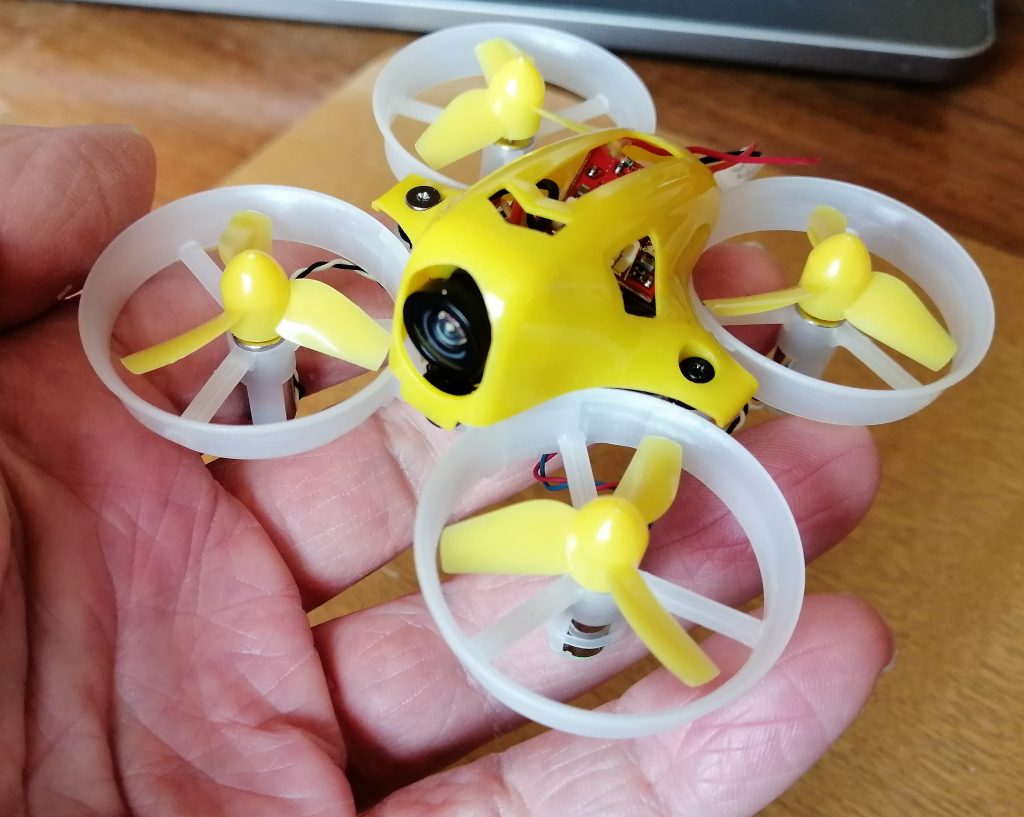 So far I’ve only tried it with an indoor quadrotor to keep me flying through this period of social distancing. That meant another huge learning curve to set up the quad using an app called Betaflight but that’s another story. Having read all that reminds me that Bob the Builder almost bought the same Jumper T16 transmitter before choosing the less complex but rather more expensive Multiplex Cockpit. Dougal is finding the Jumper quite taxing and he used to write transmitter software and has a D.Phil in computers systems (yes, he’s genuinely a Doctor) so I think Bob made the right decision. When I queried Dougal about his qualification he said if anyone expects him to be the other sort of Doctor he tells them to take two Aspirin and ring him in the morning! You can see Dougal flying the quadrotor in this month’s video. Rumour has it that in the winter Dougal will have to upgrade the Jumper to a Coat…
So far I’ve only tried it with an indoor quadrotor to keep me flying through this period of social distancing. That meant another huge learning curve to set up the quad using an app called Betaflight but that’s another story. Having read all that reminds me that Bob the Builder almost bought the same Jumper T16 transmitter before choosing the less complex but rather more expensive Multiplex Cockpit. Dougal is finding the Jumper quite taxing and he used to write transmitter software and has a D.Phil in computers systems (yes, he’s genuinely a Doctor) so I think Bob made the right decision. When I queried Dougal about his qualification he said if anyone expects him to be the other sort of Doctor he tells them to take two Aspirin and ring him in the morning! You can see Dougal flying the quadrotor in this month’s video. Rumour has it that in the winter Dougal will have to upgrade the Jumper to a Coat…
Meanwhile Bob the Builder has a new project on the bench, a twin engine camera plane that he might eventually use for FPV. I only have limited information at the moment but Bob tells me it’s going to look quite similar to this one.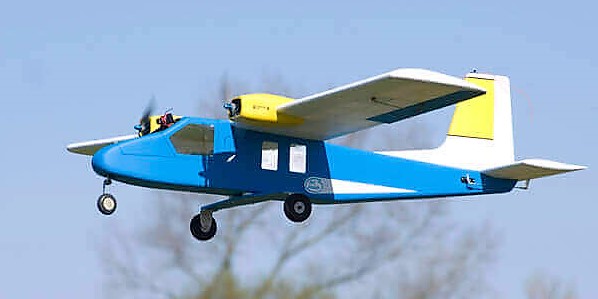 The wingspan is 1300mm and it will be powered by a pair of 2836 1400Kv PropDrive motors from HobbyKing, a pair of 40A speed controllers, and a single 4000mAh lipo. Bob seems to be re-using the tailplane and fin from an old model, a good bit of upcycling. With most of the actual building done it’s looking nice, should be a good flier.
The wingspan is 1300mm and it will be powered by a pair of 2836 1400Kv PropDrive motors from HobbyKing, a pair of 40A speed controllers, and a single 4000mAh lipo. Bob seems to be re-using the tailplane and fin from an old model, a good bit of upcycling. With most of the actual building done it’s looking nice, should be a good flier.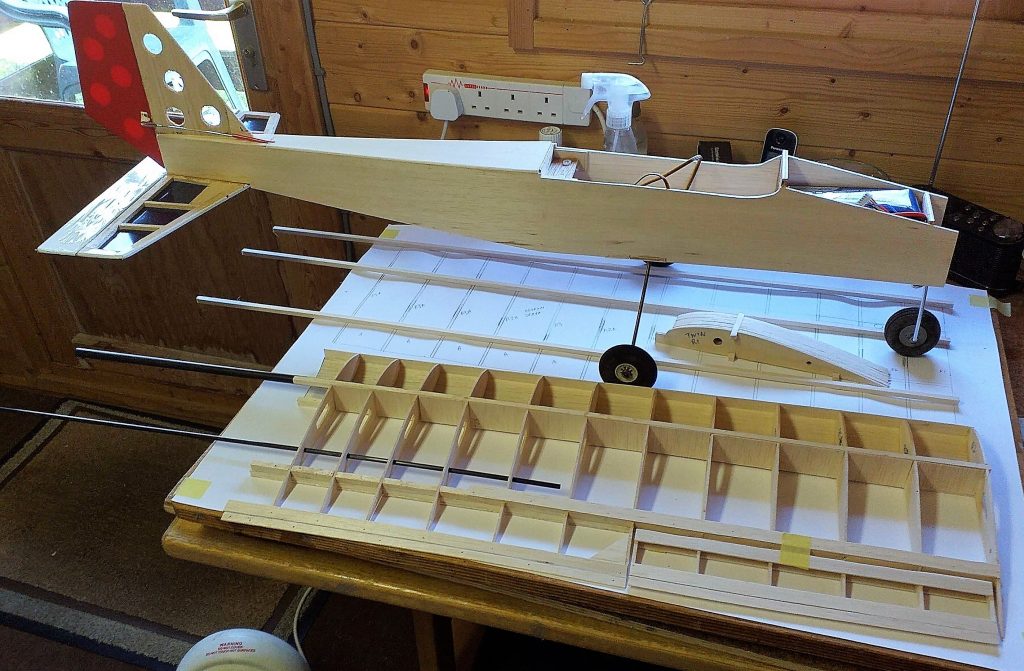
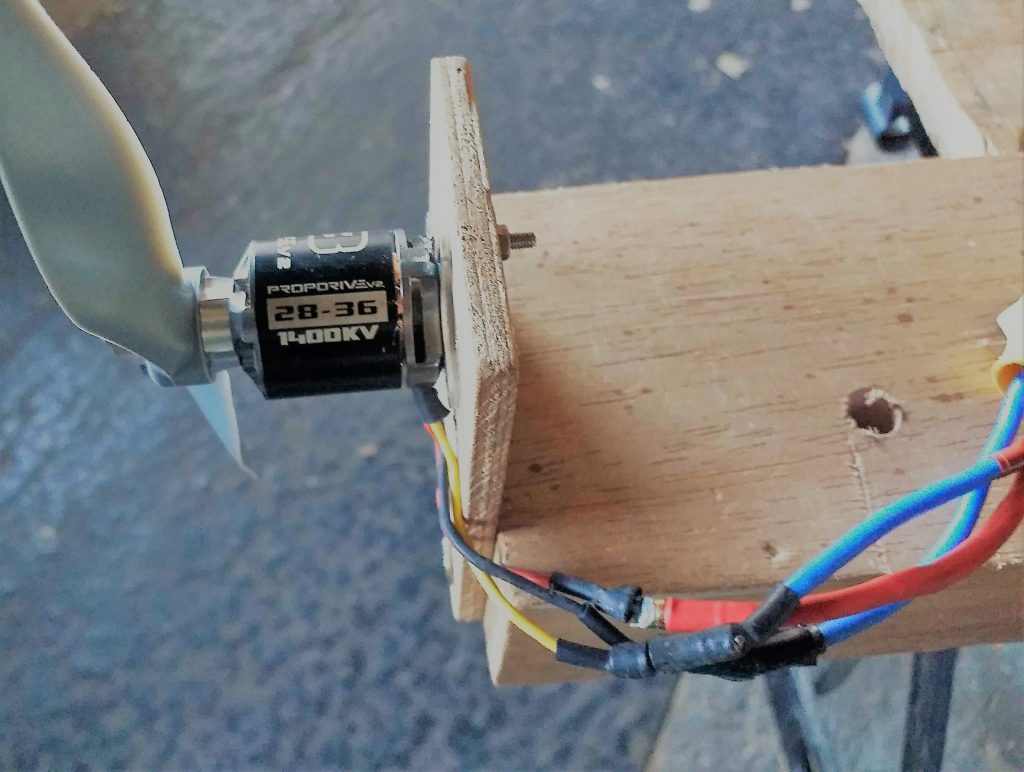 The motors will provide around 400W each which should be plenty of power. The one in the photo looks to have a pusher prop on it so expect Bob is going to correctly have both props rotating in towards the fuselage.
The motors will provide around 400W each which should be plenty of power. The one in the photo looks to have a pusher prop on it so expect Bob is going to correctly have both props rotating in towards the fuselage.
Another twin now, Mike Smith’s Partenavia Victor that he bought from Puffin Models about twelve years ago and has finally got round to finishing. At 79″ span it’s a big one and the kit was made by Modell Studio in the Czech Republic. Mike has fitted the Victor with a pair of Tornado Thumper 3542 1250KV motors and will be using a pair of 4 cell 3300 lipo packs. The quoted weight is around 10lbs but Mike is hoping his will be a bit lighter as the original used heavier nicads batteries. He’s concerned about a lack of power but looking at the motor specs I think it’ll be fine.
Mike has fitted the Victor with a pair of Tornado Thumper 3542 1250KV motors and will be using a pair of 4 cell 3300 lipo packs. The quoted weight is around 10lbs but Mike is hoping his will be a bit lighter as the original used heavier nicads batteries. He’s concerned about a lack of power but looking at the motor specs I think it’ll be fine.
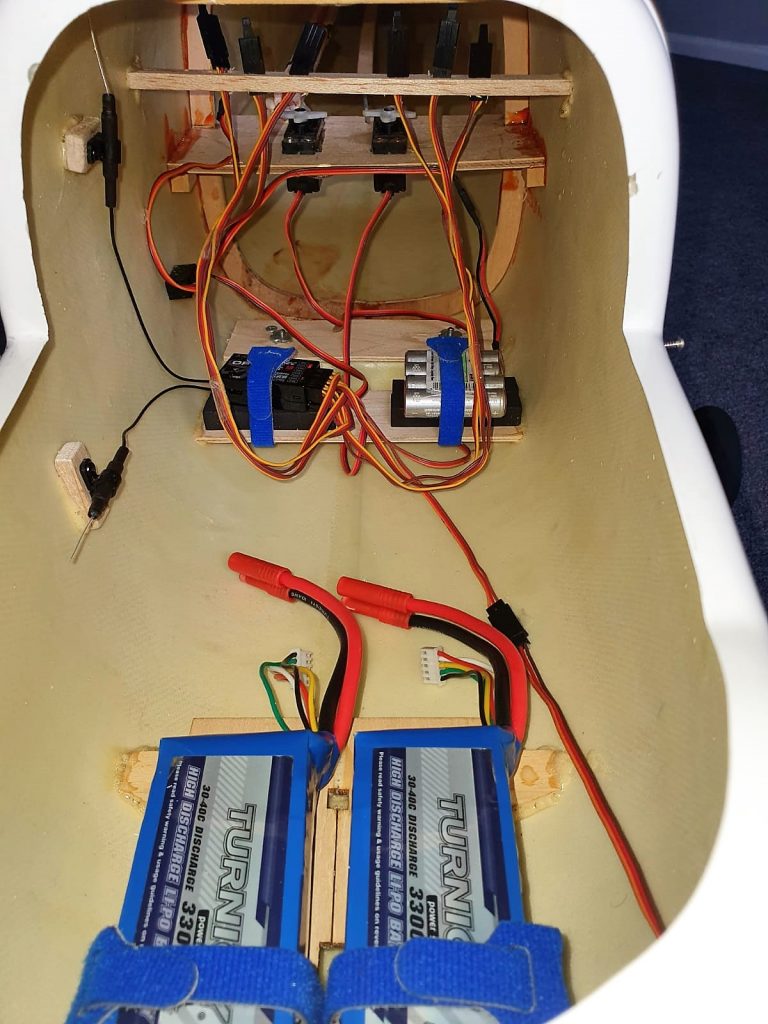 Like the full-size the model is fitted with flaps to slow it up for landing. Space for all the gear isn’t a problem and Mike managed to squeeze everything in, I reckon he should cut a hatch and join my BushMule on a parachute drop!
Like the full-size the model is fitted with flaps to slow it up for landing. Space for all the gear isn’t a problem and Mike managed to squeeze everything in, I reckon he should cut a hatch and join my BushMule on a parachute drop!
1066 has sorted through his lipos and ditched thirty five duff ones! He then charged/discharged all the remaining ones to the correct storage voltage and sent me a photo of how he’s storing them, certainly much neater than mine.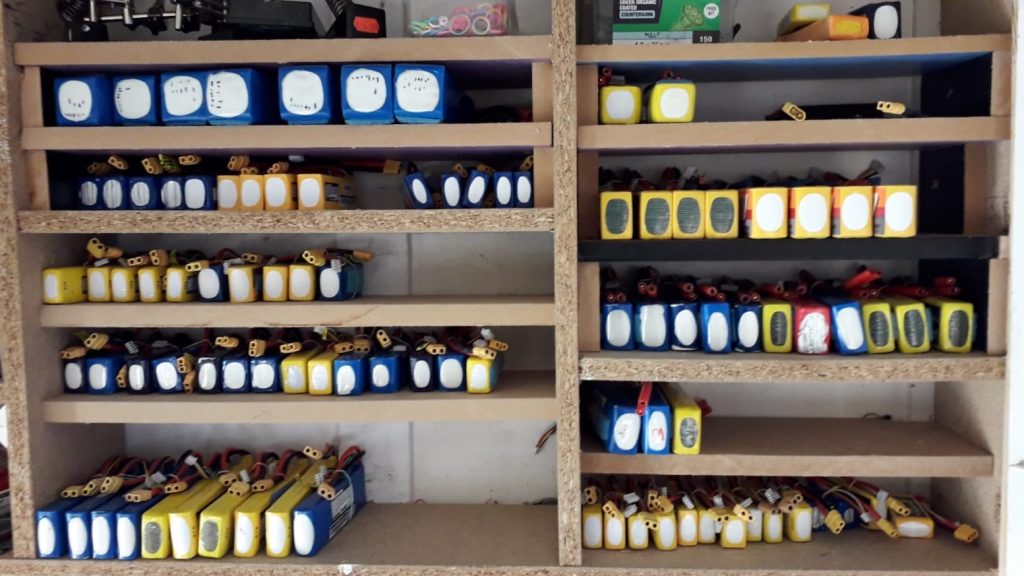 I’ve also set all mine to storage voltage but I didn’t get round to sorted out the duff ones. This gave me an idea for another Gold Star Competition: How many lipos are in my ammo box? There’s a mix of 3 & 4 cell packs of capacities from 1000mAH to 4000mAH. Would you like a clue? I’m afraid I don’t have one, your guess is as good as mine.
I’ve also set all mine to storage voltage but I didn’t get round to sorted out the duff ones. This gave me an idea for another Gold Star Competition: How many lipos are in my ammo box? There’s a mix of 3 & 4 cell packs of capacities from 1000mAH to 4000mAH. Would you like a clue? I’m afraid I don’t have one, your guess is as good as mine. I haven’t counted them yet but I struggled to get them all in there. Oh, and the balance board is still in the bottom. Please enter your guesses in the Comments, one guess each, nearest is the winner.
I haven’t counted them yet but I struggled to get them all in there. Oh, and the balance board is still in the bottom. Please enter your guesses in the Comments, one guess each, nearest is the winner.
1066 also sent me some photos of what he thinks was his last scratch built model, a Pitts Special S-1S. He cut his own foam wings and used the Avicraft Panic method to skin them. He said after all the work it was a rubbish flier and that put him off scratch building for life. He was using an OS61FSR but it really needed a 90.
He cut his own foam wings and used the Avicraft Panic method to skin them. He said after all the work it was a rubbish flier and that put him off scratch building for life. He was using an OS61FSR but it really needed a 90. The model may not have flown very well but it looks superb to me. The full-size G-BOOK was the late Brian Lecomber’s display Pitts back in the 1980’s but in 1992 it was unfortunately destroyed by a fire after landing. Apparently the fire was caused by a leak of diesel oil from the smoke system, fortunately nobody was injured.
The model may not have flown very well but it looks superb to me. The full-size G-BOOK was the late Brian Lecomber’s display Pitts back in the 1980’s but in 1992 it was unfortunately destroyed by a fire after landing. Apparently the fire was caused by a leak of diesel oil from the smoke system, fortunately nobody was injured.
Matt Takhar has sent me some info on two lockdown projects, one of which is a complete departure from his usual stuff but that one will have to wait until next month. This month I’ll just show you his latest 3D plane, an Extra 300-EXP. He says it wasn’t much of a build as it’s an Extreme Flight kit so there was little work to do.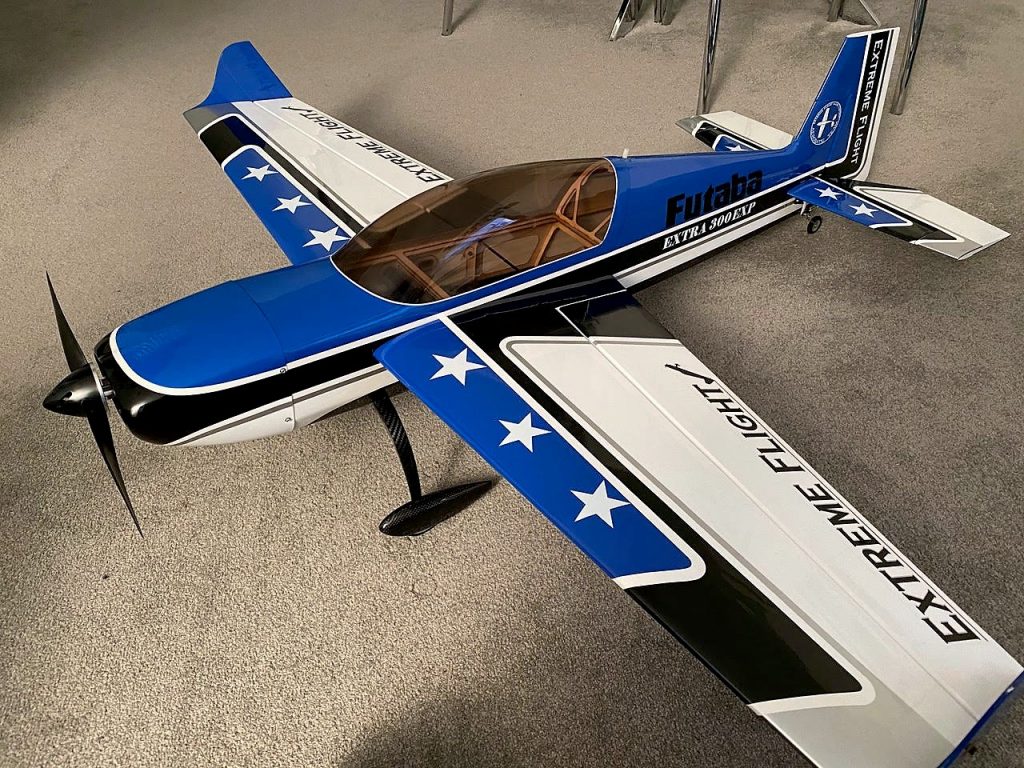 Both the wingspan and length of the Extra are 48”, the wing area 500sq. in. and the weight 42-46oz. Matt has fitted it out with an Extreme Flight Torque 2814T 829kV motor coupled to a Hobbywing Platinum Pro 50A V3 esc.
Both the wingspan and length of the Extra are 48”, the wing area 500sq. in. and the weight 42-46oz. Matt has fitted it out with an Extreme Flight Torque 2814T 829kV motor coupled to a Hobbywing Platinum Pro 50A V3 esc. He’ll be using a 12×6 APC Electric Prop and I assume it’ll be on a 4 cell lipo. The servos are all Savox SH-0257MG Micro Digitals. I love the colour scheme and no doubt it will perform as well as the other Extreme Flight models.
He’ll be using a 12×6 APC Electric Prop and I assume it’ll be on a 4 cell lipo. The servos are all Savox SH-0257MG Micro Digitals. I love the colour scheme and no doubt it will perform as well as the other Extreme Flight models.
Many of us are familiar with the Avro Lancaster that Percy Vears has been building for a while now and barring fitting the radio gear, and final testing/adjustments, the project is more or less complete. This is what Percy says about it: The airframe was built in balsa/ply from a Tony Nijhuis 72” Lancaster kit. This was finished with 18gm glass fibre cloth and Z-Poxy resin. Halfords High-Build primer was used to take out some of the bumps and dents (most of which is removed by sanding). This was then followed by a coat of Halfords Grey Primer.
This is what Percy says about it: The airframe was built in balsa/ply from a Tony Nijhuis 72” Lancaster kit. This was finished with 18gm glass fibre cloth and Z-Poxy resin. Halfords High-Build primer was used to take out some of the bumps and dents (most of which is removed by sanding). This was then followed by a coat of Halfords Grey Primer.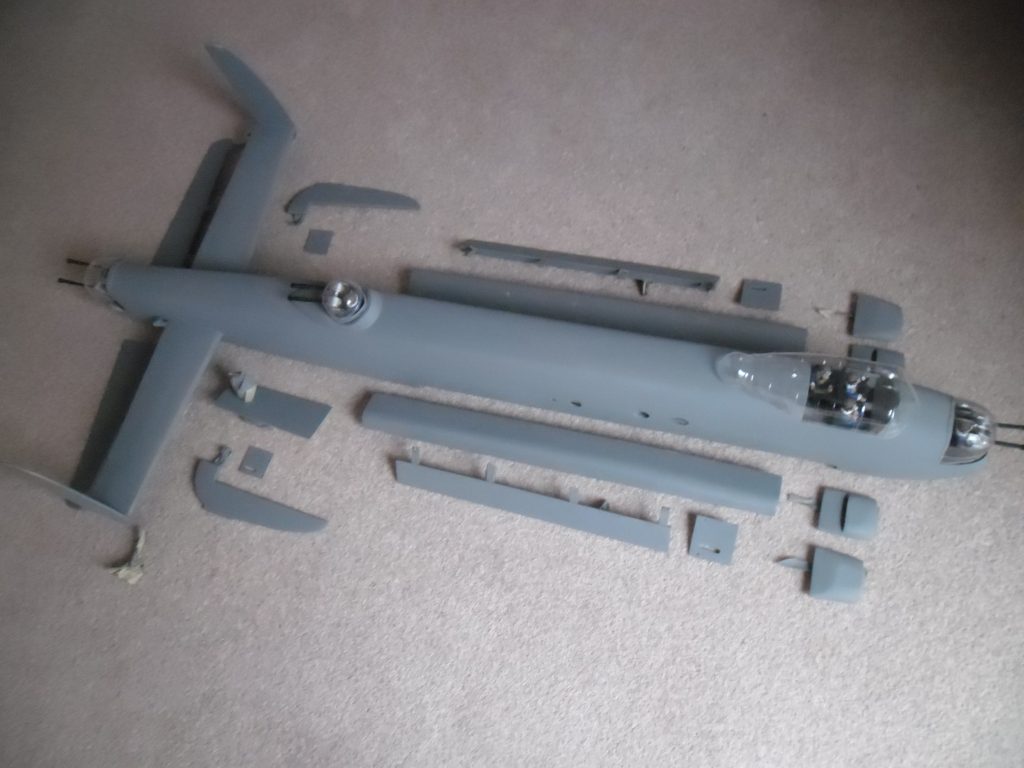 Camouflage colours on the top surfaces were Matt Dark Earth (Humbrol 29) and Matt Dark Green (Humbrol 30), and after application of the roundels, were sprayed with Halfords matt clear lacquer. The underside and fins were painted with Halfords Satin Black Lacquer. Roundels and lettering were cut from Solar Film.
Camouflage colours on the top surfaces were Matt Dark Earth (Humbrol 29) and Matt Dark Green (Humbrol 30), and after application of the roundels, were sprayed with Halfords matt clear lacquer. The underside and fins were painted with Halfords Satin Black Lacquer. Roundels and lettering were cut from Solar Film.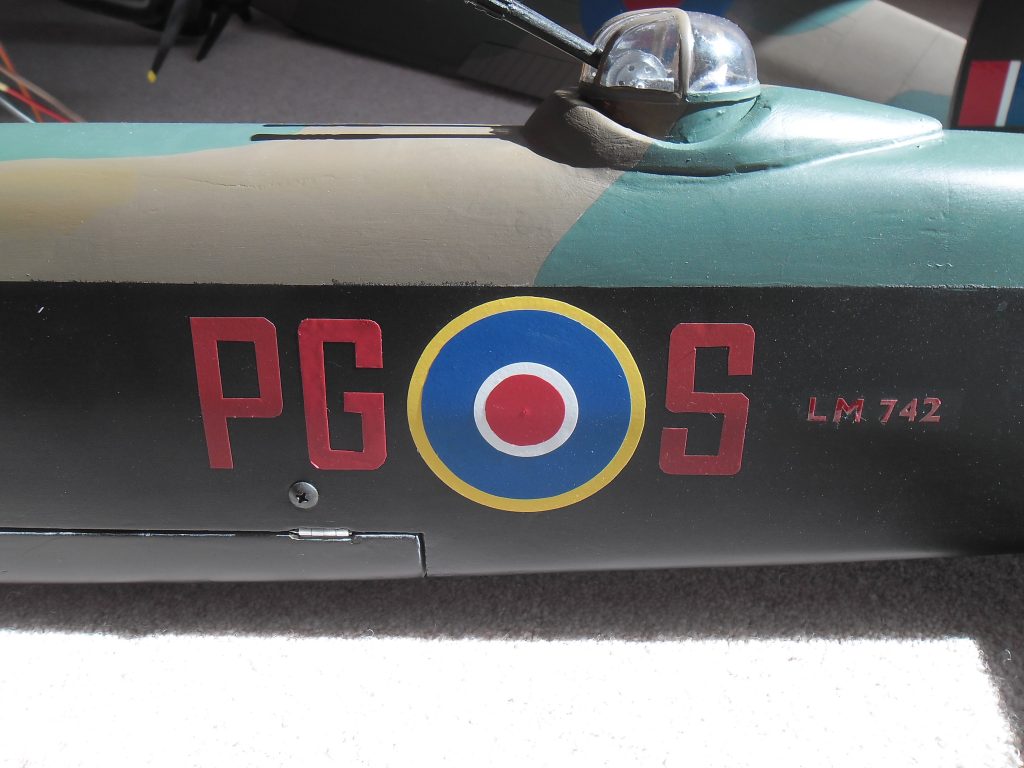 Some items required were not readily available off the shelf, so this forced me to engage in the world of 3D printing (another learning curve!). These included pilot/crew figures, Browning guns and spinners, plus other small parts.
Some items required were not readily available off the shelf, so this forced me to engage in the world of 3D printing (another learning curve!). These included pilot/crew figures, Browning guns and spinners, plus other small parts.
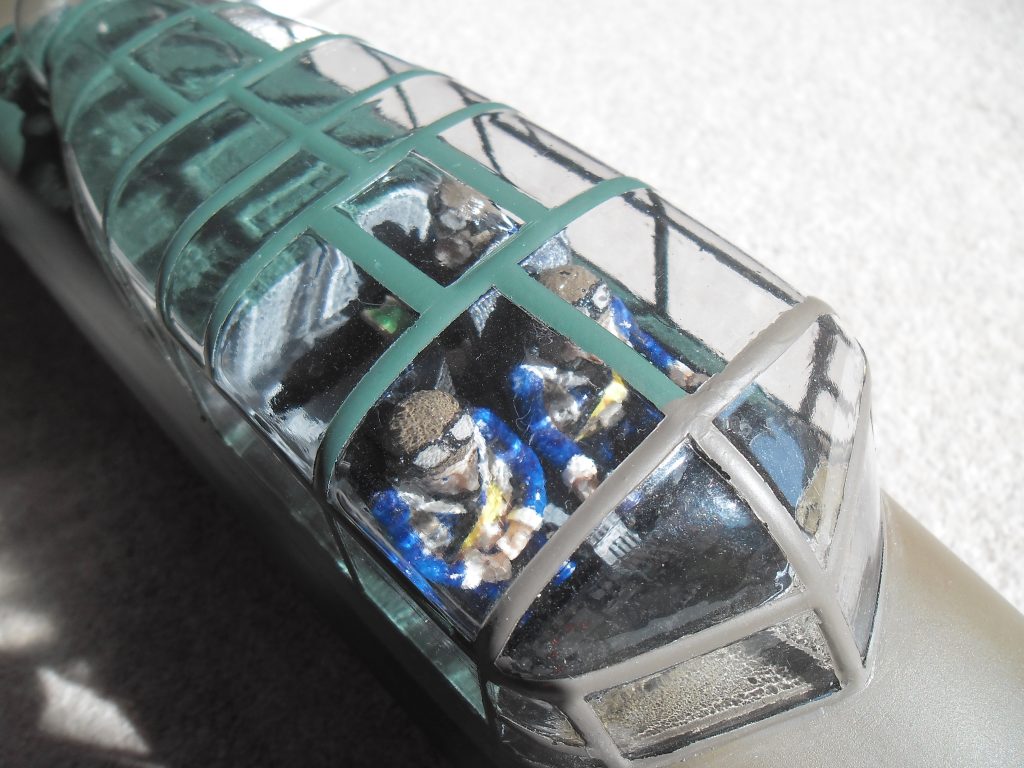
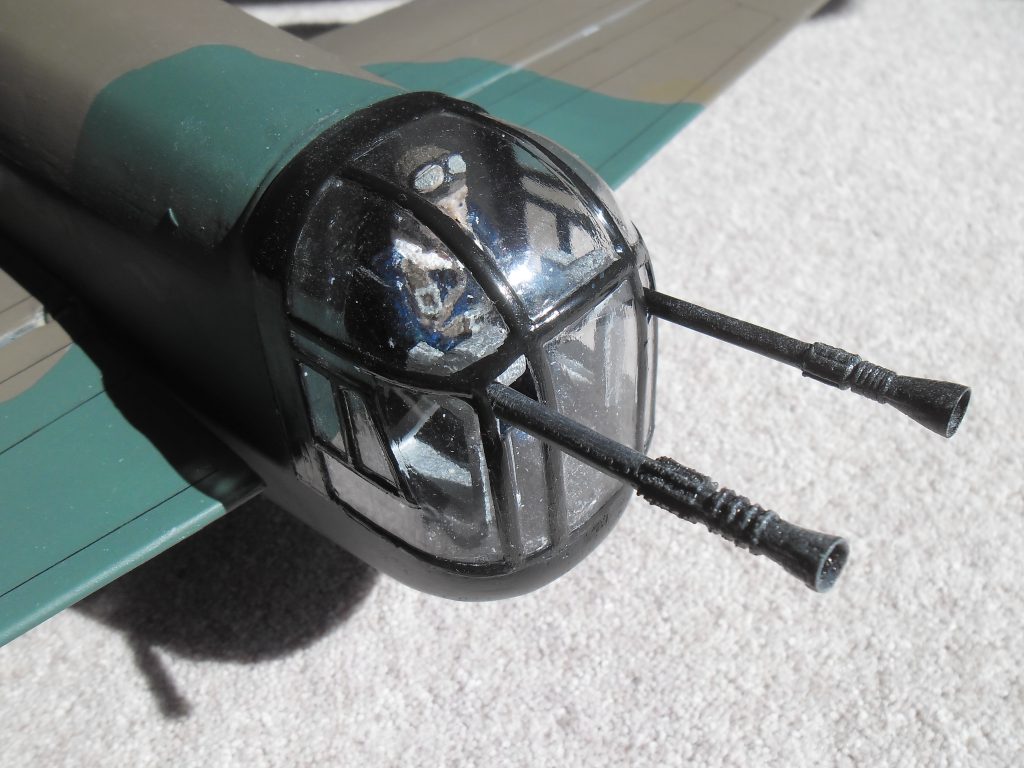 The electronic parts (apart from Tony Nijhuis supplied retracts) came from HobbyKing and are as follows:
The electronic parts (apart from Tony Nijhuis supplied retracts) came from HobbyKing and are as follows:
- Motors: 4x Turnigy D2836/8 1100kv brushless
- ESC: 4x HobbyKing 30A
- Rudder servos: 2x Turnigy TGY-D56MG (flat profile)
- Other servos: 4x Turnigy TGY-50090M
- UBEC: 5V, 5A (learnt from Vulcan – separate UBEC needed)
- Battery: 3s 5000mAh 40C
- Propellers: 4x Master Airscrew 3-blade 8×6 (2xCW & 2xCCW)
The overall weight is likely to be in the region of 3Kg (6.5lb) so performance with 700W (824W peak) is likely to allow the aircraft to lumber along at scale speed, rather than exhibit aerobatic performance.
Excellent Percy, it looks superb and I’m sure it will fly very well. At just over 100W/lb I think it will have plenty of power and should ‘lumber along’ perfectly on about half throttle.
Last month I mentioned that Dwayne Pipe was looking for some new radio gear and he replied with this: I finally lost confidence with Spektrum when on three flying occasions the aircraft just fell out of the sky for no obvious reason ( apart from my own rubbish flying). To confirm it the ailerons reversed themselves in mid-flight while I was using my Spektrum transmitter on my flight simulator at home. So I have abandoned Spektrum and bought a Futaba T6K transmitter and receivers. Nick S lent me an old Futaba transmitter and instruction manual so I got the hang of the programming, I have been transferring all my models over to Futaba which seemed to take forever.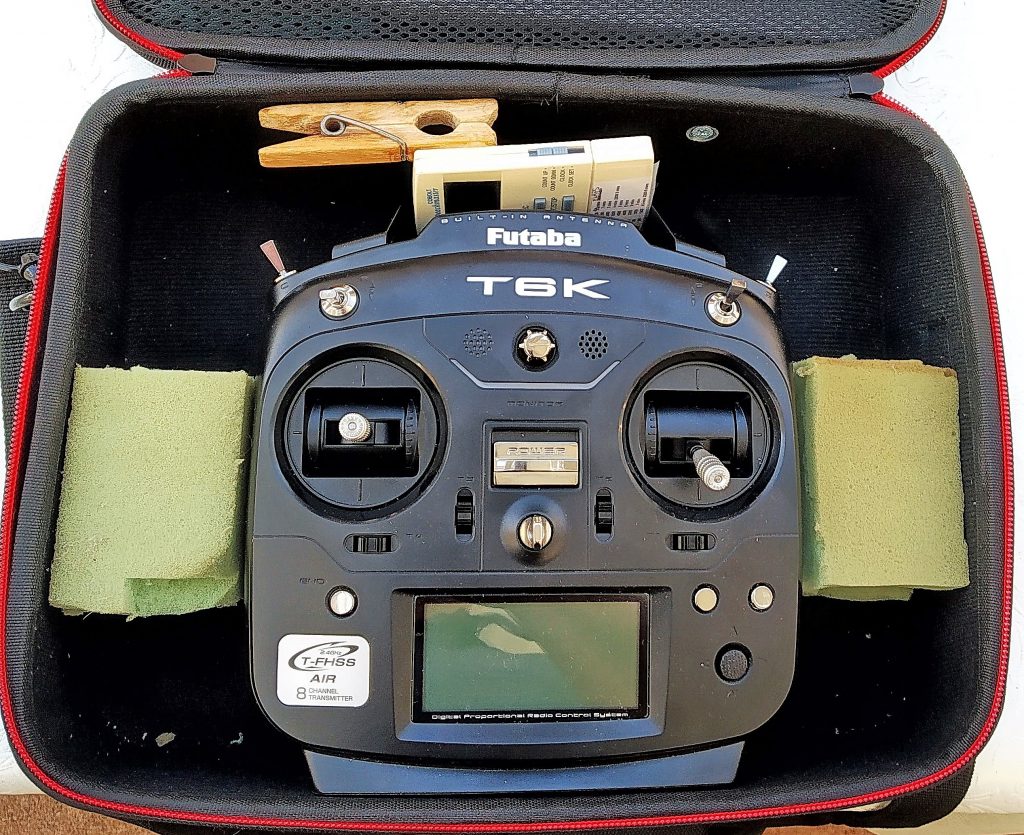 Still haven’t tried it out in real life, so that’s something to look forward to when the grownups let us out to play.
Still haven’t tried it out in real life, so that’s something to look forward to when the grownups let us out to play.
Meanwhile Dwayne has started another project and he’s doing it the proper way, starting from scratch: With all this time on our hands I have been looking for a challenging build project. I fancied a more aerobatic edf than my TSR2 (which is good at flying fast in a straight line). A BAE Hawk would have been fine but Dan’s is so good that I couldn’t compete. For Christmas, presumably to keep me out of trouble, my wife bought me an Airfix Red Arrows Folland Gnat kit, which looks really good and being mid wing should be hand launchable. So my latest project is to design a Folland Gnat using just the Airfix kit and the three section drawing that comes on the back of the box.
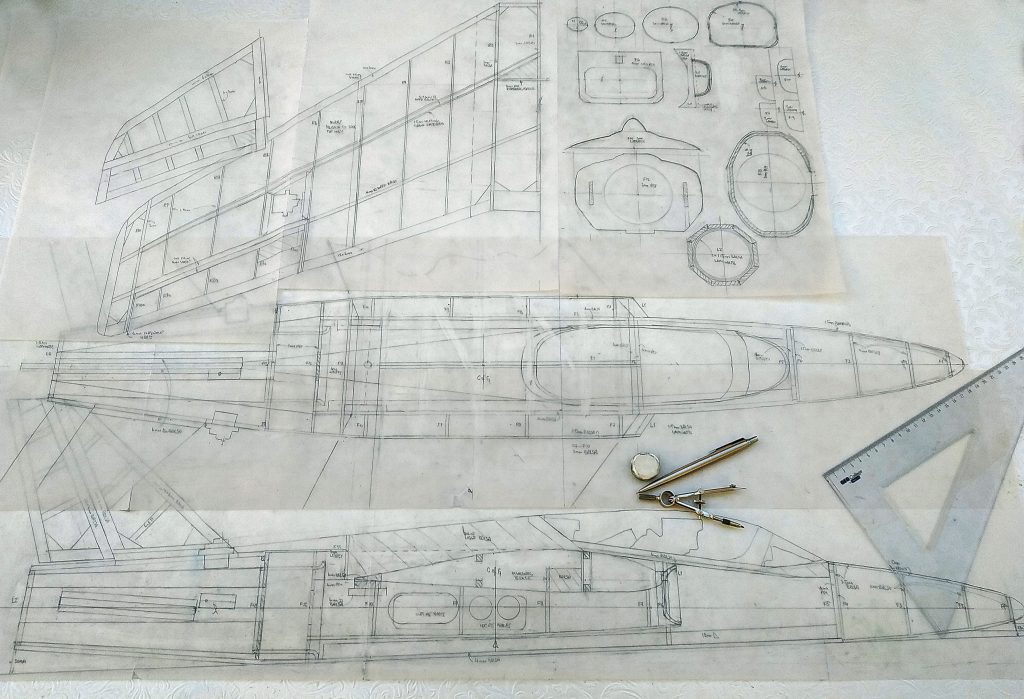 Based on a 12 blade 70 mm fan and a 36″ wingspan I have drawn out the plan using only a setsquare, rule, pencil and eraser. Very old school. I’m very impressed by your plans Dwayne and I can’t wait to see this one finished.
Based on a 12 blade 70 mm fan and a 36″ wingspan I have drawn out the plan using only a setsquare, rule, pencil and eraser. Very old school. I’m very impressed by your plans Dwayne and I can’t wait to see this one finished.
Newbie Nick has bought a 1 metre span Strike 3 DLG from Hyperflight, I took this is from their website: The Strike 3 is superbly made using 30 g/m2 Carboline spread carbon, the model is exceptionally light, while also being strong and very rigid, allowing high launches. Still air times of 2 minutes have been reported by strong launchers, and pilots enjoy the excellent performance and sweet handling. Its full span ailerons allow camber adjustment in flight, giving it a wide speed range, allowing it to be flown in moderate winds, which is unusual for 1m gliders.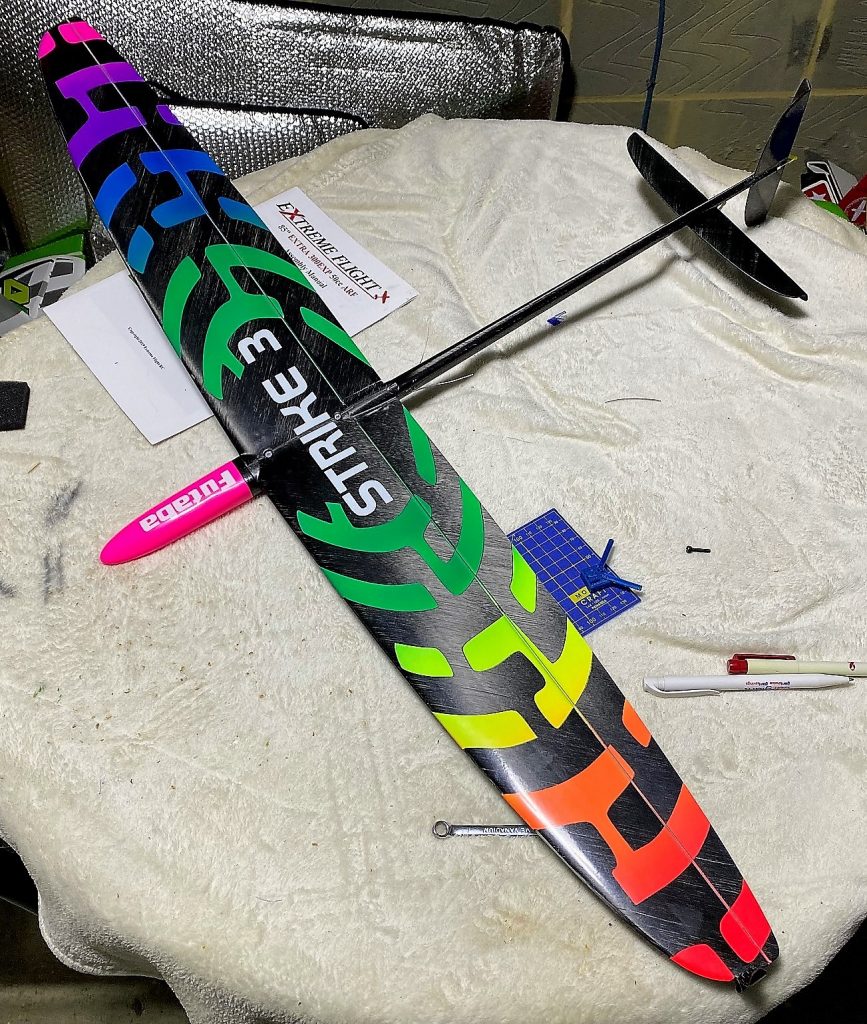 Under the Kevlar nose cone Nick has fitted four Blue Bird Nano HV digital servos to control the ailerons, elevator, and rudder. The rudder and elevator are sprung in one direction and use a Kevlar cord to pull against the tension.
Under the Kevlar nose cone Nick has fitted four Blue Bird Nano HV digital servos to control the ailerons, elevator, and rudder. The rudder and elevator are sprung in one direction and use a Kevlar cord to pull against the tension.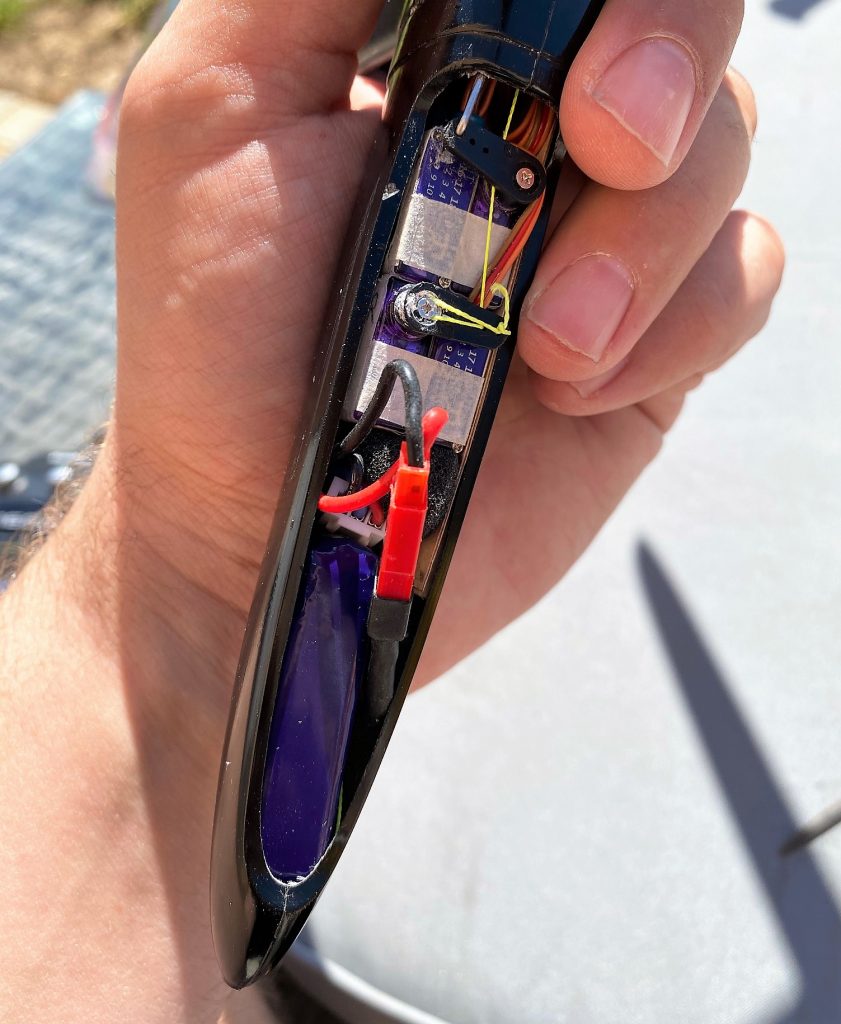
 The four servos are stuck together then glued to a thin ply tray then the whole assembly is glued into the fuselage.
The four servos are stuck together then glued to a thin ply tray then the whole assembly is glued into the fuselage.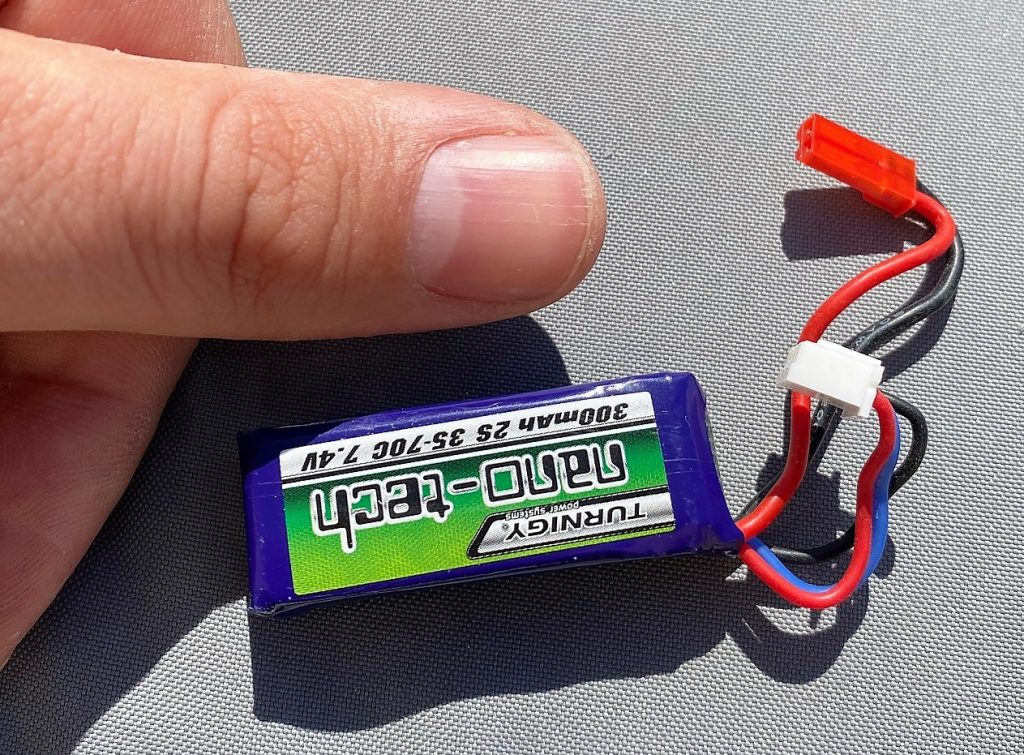 Nick has mounted the receiver under the CG and has fitted a 2 cell 300mAH battery in the nose and the all up weight is just 130g. It’s certainly an interesting very high tech model that should perform very well.
Nick has mounted the receiver under the CG and has fitted a 2 cell 300mAH battery in the nose and the all up weight is just 130g. It’s certainly an interesting very high tech model that should perform very well.
Video time now. Yes I have managed to cobble one together with contributions by myself and Dougal. Please watch the video full-screen, it’s so much better with small models flying around.If the video won’t play for you please click HERE
A pilot walked into a bar and asked for a packet of crisps.
“What flavour would you like?” asked the barman.
The pilot replies “Have you got helicopter flavour?”
“No sorry, just plane”…
Keep safe everyone – Colin Cowplain


Great Patch News Colin! Some amazing projects under way – will be great to see them fly once we’re allowed out again.
As for my transmitters, “down to his last twenty or so”? I’ve sold a couple, but I’m pretty sure it’s still way more than that! I’ll maybe have a count-up later if I can find them all.
OK, the answer is 31.
OK Dougal has started the ball rolling with his guess of 31, come on chaps get your guesses in!
Umm, 31 is the answer for my number of transmitters! But I’ll go with that for my guess at the number of batteries too.
great patch news colin i enjoyed that. some very nice models being built i look forward to seeing them fly especially the lanc! nice one ron…
The answer is 29
Hooray, someone else has bothered to answer! Come on chaps, get your answers in.
A well done with patch news. We are fortunate to have a hobby to work on during the lockdown. 42 must be the answer to the batteries!
I think these guesses are way off. I’m going for 54!
My guess is 36
Keep the guesses coming chaps, at the moment there’s a tie!
Nice one Colin only you could write about a non
happening and make it interesting.now wheres
My gold star for an answer of 28
Logically we now know that the correct answer is one of three possibilities. At the point where we were told that it’s currently a tie, we had guesses of 29, 31, 36, 42 and 54. In order for two guesses to tie, they must both be odd or both be even (otherwise one would be closer to the answer than the other), and there must be no other guesses between them. From the above list, this leaves only 30, 39 or 48 as possibilities.
I’ve already had my guess, so I’ll leave it to others to select which of these is the answer (or prove that my logic is faulty, which is also quite possible).
Look Dougal, I realised that but wasn’t going to explain it to everyone!
Keep your guesses coming gents.
Ok 39…